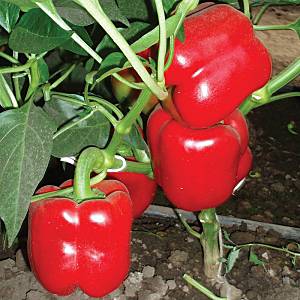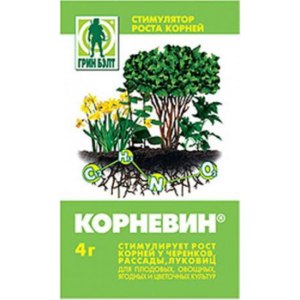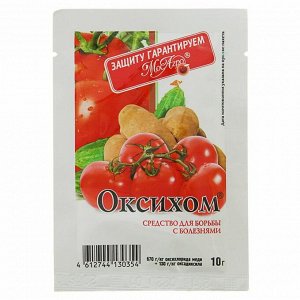Fertile pepper "Hercules", resistant to diseases and unpretentious in care
Pepper with the telling name Hercules is characterized by cold resistance and immunity to diseases characteristic of the culture. Appeared grade thanks to the efforts of domestic breeders, it is suitable for growing in central Russia, in the Urals, in Siberia. In application, it is universal, stored for a long time.
In our article - a description of the sweet pepper Hercules, its characteristics, features and yield indicators.
The content of the article
What kind of pepper is this
Mid-season crop: you will receive the first harvest 100 days after the first shoots appear. Hercules is planted in seedlings: this way he shows the best yield.
Features:

The bushes are compact, up to 50 cm long. The foliage is dark green, the leaves are medium-sized, oblong.
The recommended planting density of Hercules is 50x40.
Fruit characteristics and yield
Fruits are cuboid, slightly flattened. The peel is glossy, bright red. Vegetable weight - from 150 to 300 g.
The wall thickness is 8 mm, so the crop is well tolerated for long-distance transportation.
The pulp is sweet, crispy, juicy, few seeds. The yield is stable: about 3 kg are harvested from 1 bush.
Interesting! 100 g of bell pepper contains 25 kcal. The vegetable strengthens the immune system, prevents vision problems. Fruits are rich in vitamins A, B, C, food acids, antioxidants.
Preparation for growing
Preliminary procedures include disinfection of seeds, preparation of seedlings and beds. Let's consider each stage in detail:
- Seed disinfection protects plants from diseases and pests. Grains are disinfected with aloe juice, Bordeaux liquid or succinic acid solution. Heating in the oven for 1 hour is used as disinfection: the high temperature kills pathogens on the surface of the seeds.
 Germination of seed. The grains are wrapped in moist warm gauze, put on the windowsill. The first shoots appear in a few days. Germination strengthens the immunity of plants; to accelerate growth, a stimulant "Kornevin" is added.
Germination of seed. The grains are wrapped in moist warm gauze, put on the windowsill. The first shoots appear in a few days. Germination strengthens the immunity of plants; to accelerate growth, a stimulant "Kornevin" is added.- Seedling soil preparation. It is recommended to use a mixture of soil from the garden and bio-soil from the store. The soil is taken in equal parts, sand, sawdust, peat and humus are added to it. The resulting composition is watered with a weak solution of potassium permanganate.
- The preparation of the beds begins in the fall. The best precursors for pepper are cabbage, carrots, legumes. The earth is dug onto a shovel handle, cleaned of weeds, debris and foliage. For the winter, a solution of liquid mullein is introduced into the beds. From mid-March, the beds are dug up again, loosened with a pitchfork.
Growing seedlings
Seedlings are prepared at the end of March. For this, containers are purchased - cassettes, pots, tablets, cups. You can grow the culture in ordinary plastic cups or kefir bags. The main thing is to rinse them thoroughly with warm water and soda.
The procedure for planting and caring for the crop looks like this:
- Pour earth into the container. At a distance of 10 cm from each other, using a pencil, make grooves 1 cm deep.
- 2 seeds are placed in each hole, sprinkled with earth on top and watered with warm water.
- In the future, the soil is moistened as it dries, about once every 4 days.
- With the appearance of the first shoots, the seedlings are fertilized with liquid bird droppings.
- The bushes are kept on a warm sunny windowsill.Daylight hours for seedlings - at least 12 hours.
Growing seedlings with a pick
Picking - transplanting seedlings in a larger container. It is necessary if the plants were previously planted in cups or pots. In such conditions, the roots do not have enough space for development, more space is required. Dive the sprouts carefully so as not to damage the fragile root system. For this, containers and earth are prepared in advance.
Council. Peppers do not like picking, so it is better to immediately plant them in individual containers.
Landing
For 7-10 days, the pillbox of planting crops in the garden, watering is stopped. The best time for a dive is early morning or evening. In the beds, holes are prepared, water is poured into them.
The seedlings are taken out of containers, placed in holes, the base of the stem is slapped with soil. To protect them from frost for the first 7 days, the sprouts are covered with foil or thin glass.
Further care
Care consists of regular watering and feeding. The beds are moistened every 5-7 days. About 1 liter is spent on one bush. The water should be warm and clean. The jet is directed directly to the root. The optimal time for irrigation is morning or evening to avoid sunburn.
Heracles pepper is fed 3-4 times per season. For this, organic matter and mineral fertilizers are used: ash, ammonium nitrate, iodine, Bordeaux liquid, superphosphate. Add funds before watering. The interval between procedures is 10-15 days.
Important! The beds must be clean and well-groomed. Gardeners remove weeds and debris once a week, loosen the ground. Weeding makes the soil light and airy, which is beneficial for root and stem development.
Features of cultivation and possible difficulties
When grown in a greenhouse, a special care regimen is observed. The beds are watered less often, about once a week. Indoor ground is characterized by high humidity and stuffiness, so it is important to avoid excess liquid. Every day, the structure is ventilated by opening the vents: peppers need fresh air for healthy growth.
When applying dressings, the dosage is observed: an overabundance or lack of minerals leads to diseases. For example, excessive application of nitrogen promotes the growth of green mass, while the fruits remain small and bland. An excess of calcium and iron leads to yellowing and drying of the leaves.
Important! With the appearance of the first fruits, the bushes form. A few central shoots are left, the rest are cut off. This increases the amount of large, juicy peppers. The plant does not need weak and thin shoots.
Typical diseases and pests
Diseases and pests appear due to sudden climatic changes, heat or rain, improper care.

The following diseases are most common and dangerous:
- Late blight - fungal infection occurs due to high humidity and heat. To prevent late blight, the rules of crop rotation are observed, the soil is loosened in time, and weeds are removed. The fungus appears in the form of yellow and brown spots on the leaves, the fruits lose their elasticity and taste. Treat the disease with drugs "Quadris" or "Oxyhom".
- Powdery mildew- a virus, manifests itself as a white bloom on leaves, stems. It occurs due to contaminated soil, excessive application of mineral and organic fertilizers. For prophylaxis, spraying with iodine or a solution of copper sulfate is used, for treatment - a solution of wood ash or "HOM".
Of the pests, wireworms, bear and Colorado beetles are noted. Insects live underground and are frost-resistant. They destroy plants from the roots: they gnaw at them, because of which the stem does not receive nutrients. Dry eggshells will prevent the emergence of pests: they are scattered over the beds. To get rid of insects, use the "Typhoon" or "Hurricane" products.
Advantages and disadvantages of the variety
Of the advantages, they note attractive commercial qualities, juicy sweet pulp, versatility of use. The Hercules variety is appreciated for its immunity, cold resistance.Delicate fruits are suitable for cooking a wide variety of dishes. The thick walls of vegetables provide long-term storage.
Important! Peppers are harvested in mid to late August, when they become deep red with a glossy shade. Use the Hercules variety for canning, pickles, cooking stuffed, stewed and dried. The sweetness of the pepper is combined with cucumbers, tomatoes, chicken and fish.
There are no drawbacks in the variety. Only occasionally, due to improper care, the culture suffers from late blight or powdery mildew.
Reviews
Despite the popularity of Hercules, some gardeners were disappointed with the harvest. Let's examine a few reviews:

Evgeniy, Omsk: “The Hercules variety was planted for the first time. According to the reviews, I thought that the pepper was unpretentious in care, but I had to constantly remove the side shoots. I estimate it to my taste as "average", I expected much more. "
Irina, Chelyabinsk: “I have been planting bell peppers Hercules for a long time. I am always happy with the harvest: the peppers grow large and sweet. The variety is resistant to weather changes, frost and winds. "
Ksenia, Moscow: “I love Bulgarian peppers. I especially like the Hercules variety. I plant seedlings, the harvest is rich. I use it fresh, and part of it I freeze for the winter, after crushing it ”.
Read also:
Conclusion
The Hercules variety is suitable for both greenhouses and open ground. It is grown throughout the country: in the middle lane, the Volga region, in the Urals, in Siberia. To obtain a rich harvest, the seedling method is used.
Vegetables ripen 95-105 days after the first shoots appear. Harvested in August, used fresh and for making soups, salads and snacks.